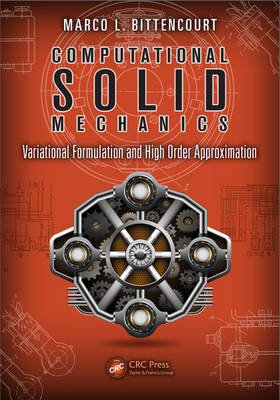
Computational Solid Mechanics
Crc Press Inc (Verlag)
978-1-4398-6001-4 (ISBN)
- Titel z.Zt. nicht lieferbar
- Versandkostenfrei
- Auch auf Rechnung
- Artikel merken
Utilizing material developed in a classroom setting and tested over a 12-year period, Computational Solid Mechanics: Variational Formulation and High-Order Approximation details an approach that establishes a logical sequence for the treatment of any mechanical problem. Incorporating variational formulation based on the principle of virtual work, this text considers various aspects of mechanical models, explores analytical mechanics and their variational principles, and presents model approximations using the finite element method. It introduces the basics of mechanics for one-, two-, and three-dimensional models, emphasizes the simplification aspects required in their formulation, and provides relevant applications.
Introduces Approximation Concepts Gradually throughout the Chapters
Organized into ten chapters, this text provides a clear separation of formulation and finite element approximation. It details standard procedures to formulate and approximate models, while at the same time illustrating their application via software. Chapter one provides a general introduction to variational formulation and an overview of the mechanical models to be presented in the other chapters. Chapter two uses the concepts on equilibrium that readers should have to introduce basic notions on kinematics, duality, virtual work, and the PVW. Chapters three to ten present mechanical models, approximation and applications to bars, shafts, beams, beams with shear, general two- and three-dimensional beams, solids, plane models, and generic torsion and plates.
Learn Theory Step by Step
In each chapter, the material profiles all aspects of a specific mechanical model, and uses the same sequence of steps for all models. The steps include kinematics, strain, rigid body deformation, internal loads, external loads, equilibrium, constitutive equations, and structural design.
The text uses MATLAB® scripts to calculate analytic and approximated solutions of the considered mechanical models.
Computational Solid Mechanics: Variational Formulation and High Order Approximation
presents mechanical models, their main hypothesis, and applications, and is intended for graduate and undergraduate engineering students taking courses in solid mechanics.
Marco L. Bittencourt has a PhD in mechanical engineering at the University of Campinas in Brazil. He was a post-doc at the University of Kentucky and a visiting professor at the Division of Applied Mathematics at Brown University. His main research area is computational mechanics with emphasis on non-linear structural mechanics, high-order finite elements, and high-performance computing applied to the design of engine components and more recently biomechanics.
INTRODUCTION. EQUILIBRIUM OF PARTICLES AND RIGID BODIES. FORMULATION AND APPROXIMATION OF BARS. FORMULATION AND APPROXIMATION OF SHAFTS. FORMULATION AND APPROXIMATION OF BEAMS IN BENDING. FORMULATION AND APPROXIMATION OF BEAM WITH SHEAR. FORMULATION AND APPROXIMATION OF 2D AND 3D BEAMS. FORMULATION AND APPROXIMATION OF SOLIDS. FORMULATION AND APPROXIMATION OF PLANE MODELS. FORMULATION AND APPROXIMATIONOF PLATES IN BENDING. References.
| Zusatzinfo | 9 Tables, black and white; 423 Illustrations, black and white |
|---|---|
| Verlagsort | Bosa Roca |
| Sprache | englisch |
| Maße | 178 x 254 mm |
| Gewicht | 1420 g |
| Themenwelt | Naturwissenschaften ► Physik / Astronomie ► Mechanik |
| Technik ► Bauwesen | |
| Technik ► Maschinenbau | |
| Technik ► Umwelttechnik / Biotechnologie | |
| ISBN-10 | 1-4398-6001-7 / 1439860017 |
| ISBN-13 | 978-1-4398-6001-4 / 9781439860014 |
| Zustand | Neuware |
| Haben Sie eine Frage zum Produkt? |
aus dem Bereich


